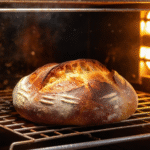Want a hands-off sourdough that fits your schedule and packs in extra flavor? This overnight sourdough bread recipe uses a slow, cold fermentation (also called retardation) to develop a crisp crust, tangy crumb, and open texture—all without an all-day bake.
During the extended chill in the fridge:
- Yeast activity slows, giving your starter’s lactic acid bacteria time to produce more acetic acid for that signature sour tang.
- Gluten structure improves, so your dough holds more gas and yields a taller loaf with lovely, irregular holes.
- Baking becomes flexible—shape in the evening, bake in the morning (or vice versa), no frantic rush.
Whether you’re juggling work, family, or just prefer a flatter morning routine, this slow-fermented sourdough lets you bake on your timetable—and taste the difference!
Easy Overnight Sourdough Bread Recipe
Want a hands-off sourdough that fits your schedule and packs in extra flavor? This overnight sourdough bread recipe uses a slow, cold fermentation (also called retardation) to develop a crisp crust, tangy crumb, and open texture—all without an all-day bake.
Equipment
- 1 Dutch Oven
- Parchment Paper
- Lame
Ingredients
- 50 grams sourdough starter healthy and vital starter is best
- 350 grams water lukewarm
- 500 grams bread flour
- 10 grams salt
Instructions
- Feed the Starter (8–12 hrs before baking): Feed your starter so it’s bubbly and active when you begin. (e.g. doubles in size, floats in water test)
- Mix Dough: In a large bowl, stir 50g starter into 350g lukewarm water. Add 500g bread flour and mix until no dry flour remains.
- Autolyse (30 min): Cover and rest for 30 minutes to hydrate the flour.
- Add Salt & Bulk Ferment: Mix in 10g salt. Cover and let rise at room temperature (4–6 hrs). Perform stretch & folds every 30 minutes during the first 2–3 hrs.
- Shape the Dough: Turn dough onto a lightly floured surface. Shape into a tight ball by folding edges into the center, then flip seam-side down and tighten surface tension.
- Cold Proof (8–24 hrs): Place seam-side up in a floured banneton or towel-lined bowl. Cover the dough and let it bulk ferment at room temperature (ideally 72–76°F / 22–24°C). Over the first 2–3 hours, perform 3–4 sets of stretch and folds every 30 minutes. The dough should become smoother and more elastic. Total bulk fermentation is usually 4–6 hours, or until the dough has nearly doubled in size and looks airy with bubbles.
- Preheat Oven: Heat oven to 500°F (260°C) with a Dutch oven inside.
- Score & Bake: Carefully turn dough onto parchment paper, score with a lame or sharp knife, and place into Dutch oven. Bake covered 20 min at 500°F, then uncovered at 450°F (230°C) for 20–30 min, until deep brown and hollow-sounding (or 210°F/100°C internal temp).
- Cool Before Slicing: Transfer to a wire rack and cool at least 1 hr before slicing.
Notes
During the extended chill in the fridge:
Yeast activity slows, giving your starter’s lactic acid bacteria time to produce more acetic acid for that signature sour tang.
Gluten structure improves, so your dough holds more gas and yields a taller loaf with lovely, irregular holes.
Baking becomes flexible—shape in the evening, bake in the morning (or vice versa), no frantic rush.
Whether you’re juggling work, family, or just prefer a flatter morning routine, this slow-fermented sourdough bread lets you bake on your timetable—and taste the difference!
